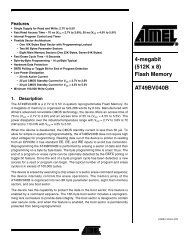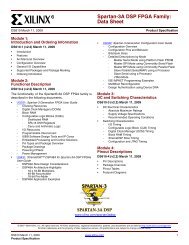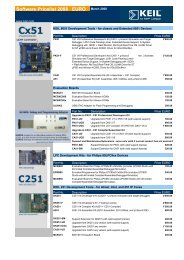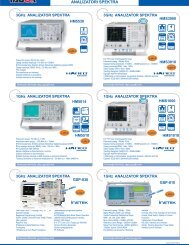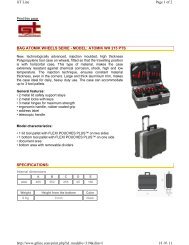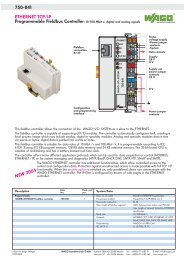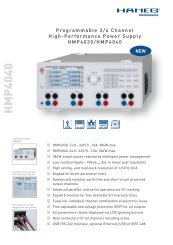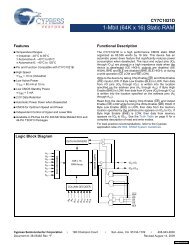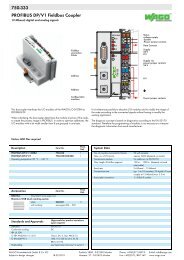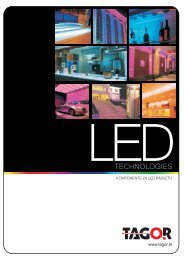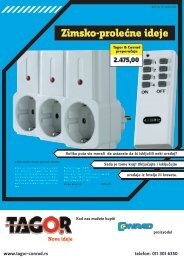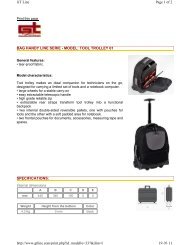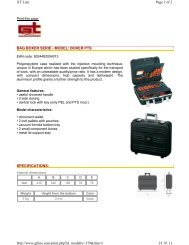PIC12F683 Data Sheet - Microchip
PIC12F683 Data Sheet - Microchip
PIC12F683 Data Sheet - Microchip
Create successful ePaper yourself
Turn your PDF publications into a flip-book with our unique Google optimized e-Paper software.
<strong>PIC12F683</strong><br />
3.4.3 LP, XT, HS MODES<br />
The LP, XT and HS modes support the use of quartz<br />
crystal resonators or ceramic resonators connected to<br />
OSC1 and OSC2 (Figure 3-3). The mode selects a low,<br />
medium or high gain setting of the internal<br />
inverter-amplifier to support various resonator types<br />
and speed.<br />
LP Oscillator mode selects the lowest gain setting of the<br />
internal inverter-amplifier. LP mode current consumption<br />
is the least of the three modes. This mode is designed to<br />
drive only 32.768 kHz tuning-fork type crystals (watch<br />
crystals).<br />
XT Oscillator mode selects the intermediate gain<br />
setting of the internal inverter-amplifier. XT mode<br />
current consumption is the medium of the three modes.<br />
This mode is best suited to drive resonators with a<br />
medium drive level specification.<br />
HS Oscillator mode selects the highest gain setting of the<br />
internal inverter-amplifier. HS mode current consumption<br />
is the highest of the three modes. This mode is best<br />
suited for resonators that require a high drive setting.<br />
Figure 3-3 and Figure 3-4 show typical circuits for<br />
quartz crystal and ceramic resonators, respectively.<br />
FIGURE 3-3:<br />
QUARTZ CRYSTAL<br />
OPERATION (LP, XT OR<br />
HS MODE)<br />
Note 1: Quartz crystal characteristics vary according<br />
to type, package and manufacturer. The<br />
user should consult the manufacturer data<br />
sheets for specifications and recommended<br />
application.<br />
2: Always verify oscillator performance over<br />
the VDD and temperature range that is<br />
expected for the application.<br />
3: For oscillator design assistance, reference<br />
the following <strong>Microchip</strong> Applications Notes:<br />
• AN826, “Crystal Oscillator Basics and<br />
Crystal Selection for rfPIC ® and PIC ®<br />
Devices” (DS00826)<br />
• AN849, “Basic PIC ® Oscillator Design”<br />
(DS00849)<br />
• AN943, “Practical PIC ® Oscillator<br />
Analysis and Design” (DS00943)<br />
• AN949, “Making Your Oscillator Work”<br />
(DS00949)<br />
FIGURE 3-4:<br />
CERAMIC RESONATOR<br />
OPERATION<br />
(XT OR HS MODE)<br />
PIC ® MCU<br />
OSC1/CLKIN<br />
PIC ® MCU<br />
C1<br />
To Internal<br />
Logic<br />
C1<br />
OSC1/CLKIN<br />
To Internal<br />
Logic<br />
RP (3)<br />
RF (2)<br />
Sleep<br />
Quartz<br />
Crystal<br />
RF (2)<br />
Sleep<br />
C2 Ceramic<br />
(1) RS<br />
Resonator<br />
OSC2/CLKOUT<br />
C2<br />
RS (1)<br />
OSC2/CLKOUT<br />
Note 1: A series resistor (RS) may be required for<br />
quartz crystals with low drive level.<br />
2: The value of RF varies with the Oscillator mode<br />
selected (typically between 2 MΩ to 10 MΩ).<br />
Note<br />
1: A series resistor (RS) may be required for<br />
ceramic resonators with low drive level.<br />
2: The value of RF varies with the Oscillator mode<br />
selected (typically between 2 MΩ to 10 MΩ).<br />
3: An additional parallel feedback resistor (RP)<br />
may be required for proper ceramic resonator<br />
operation.<br />
DS41211D-page 22<br />
© 2007 <strong>Microchip</strong> Technology Inc.



